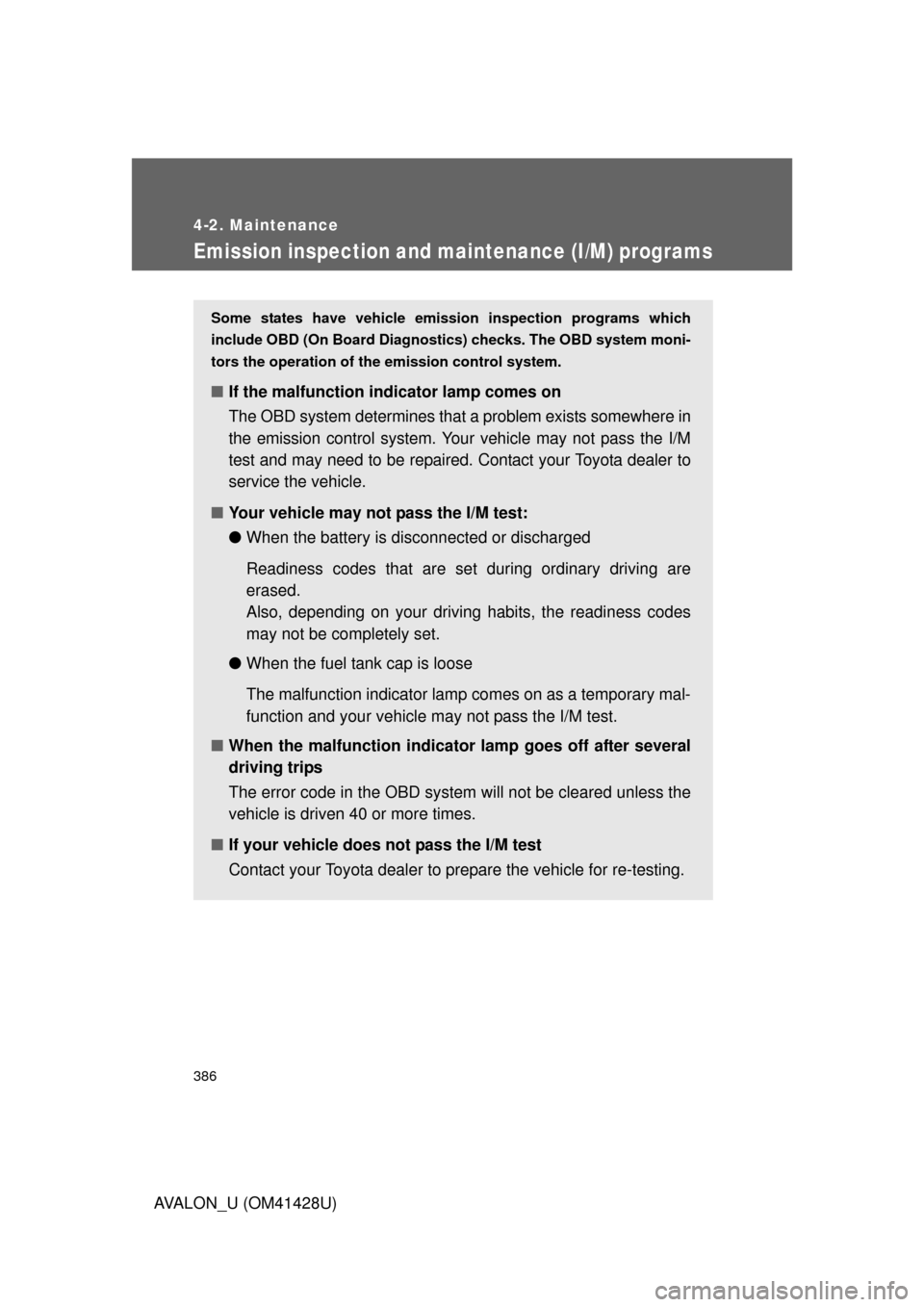Page 2 of 564

TABLE OF CONTENTSIndex
2
AVALON_U (OM41428U)
1-1. Key information
Keys ..................................... 24
1-2. Opening, closing and locking
the doors and trunk
Smart key system................. 26
Wireless remote control ....... 38
Doors.................................... 43
Trunk .................................... 50
1-3. Adjustable components
(seats, steering wheel,
mirrors)
Front seats ........................... 54
Rear seats ............................ 56
Driving position memory
system ................................ 58
Head restraints ..................... 62
Seat belts ............................. 65
Steering wheel ..................... 73
Inside rear view mirror.......... 75
Outside rear view mirrors ..... 771-4. Opening and closing the
windows and moon roof
Power windows..................... 80
Moon roof ............................. 83
1-5. Refueling
Opening the fuel tank
cap ...................................... 87
1-6. Theft deterrent system
Engine immobilizer
system ................................ 91
Alarm .................................... 94
Theft prevention labels
(U.S.A.) ............................... 98
1-7. Safety information
Correct driving posture ......... 99
SRS airbags ....................... 101
Front passenger occupant
classification system ......... 114
Child restraint systems ....... 120
Installing child restraints ..... 125
1Before driving
Page 23 of 564

Before driving1
23
AVALON_U (OM41428U)
1-1. Key information
Keys ................................... 24
1-2. Opening, closing and locking
the doors and trunk
Smart key system .............. 26
Wireless remote control ..... 38
Doors ................................. 43
Trunk .................................. 50
1-3. Adjustable components
(seats, steering wheel,
mirrors)
Front seats ......................... 54
Rear seats.......................... 56
Driving position memory
system ............................. 58
Head restraints................... 62
Seat belts ........................... 65
Steering wheel ................... 73
Inside rear view mirror ....... 75
Outside rear view
mirrors.............................. 771-4. Opening and closing the
windows and moon roof
Power windows .................. 80
Moon roof ........................... 83
1-5. Refueling
Opening the fuel tank
cap ................................... 87
1-6. Theft deterrent system
Engine immobilizer
system ............................. 91
Alarm.................................. 94
Theft prevention labels
(U.S.A.) ............................ 98
1-7. Safety information
Correct driving posture....... 99
SRS airbags ..................... 101
Front passenger occupant
classification system ...... 114
Child restraint systems..... 120
Installing child
restraints ........................ 125
Page 87 of 564
87
1
Before driving
AVALON_U (OM41428U)
1-5. Refueling
Opening the fuel tank cap
Perform the following steps to open the fuel tank cap.
■Before refueling the vehicle
Turn the “ENGINE START STOP” switch or the engine switch
OFF and ensure that all the doors and windows are closed.
■Opening the fuel tank cap
Press the fuel filler door
opener switch.
Turn the fuel tank cap slowly
to open.
Hang the fuel tank cap on the
back of the fuel filler door.
Page 88 of 564
88 1-5. Refueling
AVALON_U (OM41428U)
Closing the fuel tank cap
After refueling, turn the fuel tank
cap clockwise until you hear a
click. The cap will revolve slightly
in the opposite direction once
released.
■Fuel types
Use unleaded gasoline. (Octane Rating 87 [Research Octane Number 91] or
higher)
■Fuel tank capacity
Approximately 18.5 gal. (70 L, 15.4 Imp.gal.)
■When the fuel filler door opener switch is inoperable
The lever can be used to open the fuel
filler door if the fuel filler door cannot be
opened using the inside switch because
the battery discharged or for any other
reason.
Page 89 of 564

89 1-5. Refueling
1
Before driving
AVALON_U (OM41428U)
CAUTION
■When refueling the vehicle
Observe the following precautions while refueling the vehicle. Failure to do
so, may result in death or serious injury.
●Before opening the fuel door, touch the vehicle or some other metal sur-
face to discharge any static electricity.
It is important to discharge static electricity because sparks resulting from
static electricity may cause the fuel vapors to ignite.
●Always hold the grips on the fuel tank cap and turn it slowly to remove it.
A whooshing sound may be heard when the fuel tank cap is loosened.
Wait until the sound cannot be heard before fully removing the cap. In hot
weather, pressurized fuel may spray out of the filler neck and cause injury.
●Do not allow anyone that has not discharged static electricity from their
bodies to come close to an open fuel tank.
●Do not inhale vaporized fuel.
Fuel contains substances that are harmful if inhaled.
●Do not smoke while refueling the vehicle.
Doing so may cause the fuel to ignite and cause a fire.
●Do not return to the vehicle or touch any person or object that is statically
charged.
This may cause static electricity to build up, resulting in a possible ignition
hazard.
■When replacing the fuel tank cap
Do not use anything but a genuine Toyota fuel tank cap designed for your
vehicle. Failure to do so may cause a fire or other incident which may result
in death or serious injury.
Page 200 of 564
200
AVALON_U (OM41428U)
2-5. Driving information
Cargo and luggage
Capacity and distribution
Cargo capacity depends on the total weight of the occupants.
(Cargo capacity) = (Total load capacity) – (Total weight of occupants)
Steps for Determining Correct Load Limit—
(1) Locate the statement “The combined weight of occupants and
cargo should never exceed XXX kg or XXX lbs.” on your vehi-
cle’s placard.
(2) Determine the combined weight of the driver and passengers
that will be riding in your vehicle.
(3) Subtract the combined weight of the driver and passengers from
XXX kg or XXX lbs.
Take notice of the following information about storage precau-
tions, cargo capacity and load.
●Stow cargo and luggage in the trunk whenever possible. Be
sure all items are secured in place.
●Be careful to keep the vehicle level. Placing the weight as far
forward as possible helps maintain vehicle balance.
●For better fuel economy, do not carry unnecessary weight.
Page 386 of 564

386
4-2. Maintenance
AVALON_U (OM41428U)
Emission inspection and maintenance (I/M) programs
Some states have vehicle emission inspection programs which
include OBD (On Board Diagnostics) checks. The OBD system moni-
tors the operation of the emission control system.
■If the malfunction indicator lamp comes on
The OBD system determines that a problem exists somewhere in
the emission control system. Your vehicle may not pass the I/M
test and may need to be repaired. Contact your Toyota dealer to
service the vehicle.
■Your vehicle may not pass the I/M test:
●When the battery is disconnected or discharged
Readiness codes that are set during ordinary driving are
erased.
Also, depending on your driving habits, the readiness codes
may not be completely set.
●When the fuel tank cap is loose
The malfunction indicator lamp comes on as a temporary mal-
function and your vehicle may not pass the I/M test.
■When the malfunction indicator lamp goes off after several
driving trips
The error code in the OBD system will not be cleared unless the
vehicle is driven 40 or more times.
■If your vehicle does not pass the I/M test
Contact your Toyota dealer to prepare the vehicle for re-testing.
Page 420 of 564

420 4-3. Do-it-yourself maintenance
AVALON_U (OM41428U)
.
■Tire inflation pressure check interval
You should check tire inflation pressure every two weeks, or at least
once a month.
Do not forget to check the spare.
■Effects of incorrect tire inflation pressure
Driving with incorrect tire inflation pressure may result in the following:
●Reduced fuel efficiency
●Reduced driving comfort and tire life
●Reduced safety
●Damage to the drive train
If a tire needs frequent refilling, have it checked by your Toyota dealer.
■Instructions for checking tire inflation pressure
When checking tire inflation pressure, observe the following:
●Check only when the tires are cold.
If your vehicle has been parked for at least 3 hours and has not been
driven for more than 1 mile or 1.5 km, you will get an accurate cold
tire inflation pressure reading.
●Always use a tire pressure gauge.
The appearance of the tire can be misleading. In addition, tire infla-
tion pressures that are even just a few pounds off can degrade ride
and handling.
●Do not bleed or reduce tire inflation pressure after driving. It is normal
for the tire inflation pressure to be higher after driving.
●Never exceed the vehicle capacity weight.
Passengers and luggage weight should be placed so that the vehicle
is balanced.